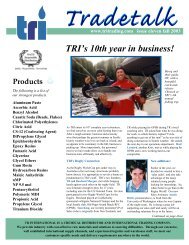Chemical buyers and suppliers work Green from different angles
Chemical buyers and suppliers work Green from different angles
Chemical buyers and suppliers work Green from different angles
You also want an ePaper? Increase the reach of your titles
YUMPU automatically turns print PDFs into web optimized ePapers that Google loves.
But he insists that getting involved early helps influence their direction <strong>and</strong> underst<strong>and</strong> their<br />
parameters, so Dow Corning can align its supply chain in the most effective way.<br />
But beyond compliance to regulatory issues, Dow Corning is <strong>work</strong>ing with <strong>suppliers</strong> to<br />
incorporate more green thinking <strong>and</strong> product stewardship at the design phase of its products.<br />
"Benign by design" is a phrase often used to sum up the strategy, but there is clearly a costfocused<br />
business strategy at <strong>work</strong>.<br />
"We're looking to design out whatever might be an area of concern—toxic chemicals,<br />
unnecessary use of energy, or areas where we can cut costs out of the process," Huckle says of<br />
the company's "eco design" strategy. "And we make that process increasingly clear to our<br />
<strong>suppliers</strong> in the hope that they will know better how to serve us <strong>and</strong> what points are of particular<br />
importance to us."<br />
CLICK HERE to see Dow Corning’s REACH page<br />
Case Study: Texas Instruments paints its supply base <strong>Green</strong><br />
When you think of Texas Instruments, you may not think of chemicals. But the procurement<br />
organization at the Dallas-based electronics giant certainly thinks of chemicals—a lot. And much<br />
of that thinking involves how the chemicals TI uses will impact the environment.<br />
The semiconductor <strong>and</strong> electronic component manufacturing process requires the use of a variety<br />
of wet chemicals <strong>and</strong> alcohols, photoresists <strong>and</strong> hydrogen peroxide. TI currently has four<br />
procurement staffers dedicated to managing its sizeable chemicals spend. But as Bryan Vonfeldt,<br />
manager for chemicals <strong>and</strong> gas procurement for TI worldwide, is quick to point out, his team<br />
spends a lot of time collaborating with TI's Environmental Safety <strong>and</strong> Health organization to<br />
continuously paint its chemicals spend a darker shade of green.<br />
To start with, TI has a list of banned chemical substances that cannot—<strong>and</strong> will not—be sourced<br />
by TI's procurement team. Tim Yeakley, manger of process <strong>and</strong> product strategy in the<br />
worldwide Environmental Safety <strong>and</strong> Health (ESH) organization, explains there are several ways<br />
a substance will get on the list, the most common being regulatory compliance or customer<br />
requirements.<br />
If a substance is added to the banned list (or it looks like it may be soon), the sourcing team at TI<br />
will first consult the incumbent supplier to see if they can provide an adequate substitute.<br />
"Usually, the supplier knows this is coming before we do <strong>and</strong> is <strong>work</strong>ing on it <strong>and</strong> has an option<br />
for us," Yeakley says. And Vonfeldt points out that TI's continuous improvement processes in<br />
these areas focus on <strong>suppliers</strong> designing out any banned substances as early as possible.<br />
The ESH organization at TI has long maintained a Horizon Review process where potential<br />
regulations around the world are tracked <strong>and</strong> customer input is considered. The ESH team also<br />
solicits input <strong>from</strong> various internal organizations, including procurement, manufacturing, <strong>and</strong><br />
engineering.





